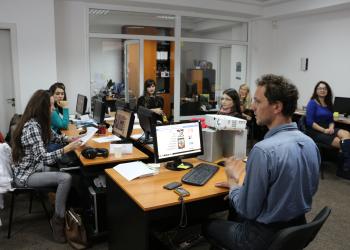07 December 2015
1547 reads

“Hate speech in social networks” was the topic of a Discussion Club meeting at the School of Advanced Journalism. Activist and journalist Oleg Brega spoke to students about the impact that an irresponsible joke intensely promoted on online platforms can have on a person and on society.
The popularity of social networks keeps growing, that is why the education of young people in the spirit of responsibility for online media products should be the main objective of society and especially of journalists. That was the key message that activist Oleg Brega addressed to students.
Being aware of everything that is published on Facebook and on other social networks, the guest presented to the students of the School of Advanced Journalism several examples with direct or indirect instigation to hatred and social discrimination. He also said that hate speech can begin from apparently innocent “little jokes”, graphic signs, caricatures, sayings and proverbs. A picture placed in a certain context can often generate stigmatizing attitudes and preconceptions towards a social group or even an entire nation.
“Such ‘jokes’ are intensely shared on social networks, being available to anyone,” Oleg Brega told students, underlining that for this reason journalists must be aware of their social responsibility, while the sieve through which they sift information “should be finer and finer so as not to let dangerous ideas through.”
When asked how instigation to hatred can be identified in an apparently neutral picture, Oleg Brega said: “First of all, we should look at who shares the picture, and then we should be careful who we take it from and send forward. People don’t always do it on purpose; sometimes they speak badly of a discriminated group either out of ignorance or because they are poorly informed. Some, who are more educated, know how to avoid temptation, while others, less educated, can turn an irresponsible slogan into reality.”
Students showed their interest in the topic and, in their turn, gave examples of online instigation to hatred. “Although the law prohibits hate speech and stipulates sanctions, including penal punishments, we haven’t yet heard of anyone being punished for such messages,” student Irina Gusan said. “Today’s discussion strengthened my feeling of social responsibility towards the people who surround me and whom I can influence,” she added. Tolerance and responsibility are two key elements of the “The media doesn’t hate” campaign supported by the Independent Journalism Center. Through its activities, the IJC encourages journalists to do their job professionally and to write correctly and objectively about the representatives of various socially disadvantaged groups and minorities.
___________
The Discussion Club meeting took place within “The media doesn’t hate!” campaign, which is part of the “Combating hate speech in online media and social networks” project implemented with the support of Civil Rights Defenders (Sweden), IJC partner.
The popularity of social networks keeps growing, that is why the education of young people in the spirit of responsibility for online media products should be the main objective of society and especially of journalists. That was the key message that activist Oleg Brega addressed to students.
Being aware of everything that is published on Facebook and on other social networks, the guest presented to the students of the School of Advanced Journalism several examples with direct or indirect instigation to hatred and social discrimination. He also said that hate speech can begin from apparently innocent “little jokes”, graphic signs, caricatures, sayings and proverbs. A picture placed in a certain context can often generate stigmatizing attitudes and preconceptions towards a social group or even an entire nation.
“Such ‘jokes’ are intensely shared on social networks, being available to anyone,” Oleg Brega told students, underlining that for this reason journalists must be aware of their social responsibility, while the sieve through which they sift information “should be finer and finer so as not to let dangerous ideas through.”
When asked how instigation to hatred can be identified in an apparently neutral picture, Oleg Brega said: “First of all, we should look at who shares the picture, and then we should be careful who we take it from and send forward. People don’t always do it on purpose; sometimes they speak badly of a discriminated group either out of ignorance or because they are poorly informed. Some, who are more educated, know how to avoid temptation, while others, less educated, can turn an irresponsible slogan into reality.”
Students showed their interest in the topic and, in their turn, gave examples of online instigation to hatred. “Although the law prohibits hate speech and stipulates sanctions, including penal punishments, we haven’t yet heard of anyone being punished for such messages,” student Irina Gusan said. “Today’s discussion strengthened my feeling of social responsibility towards the people who surround me and whom I can influence,” she added. Tolerance and responsibility are two key elements of the “The media doesn’t hate” campaign supported by the Independent Journalism Center. Through its activities, the IJC encourages journalists to do their job professionally and to write correctly and objectively about the representatives of various socially disadvantaged groups and minorities.
___________
The Discussion Club meeting took place within “The media doesn’t hate!” campaign, which is part of the “Combating hate speech in online media and social networks” project implemented with the support of Civil Rights Defenders (Sweden), IJC partner.










